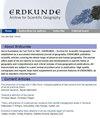International tourism and urban transformation in Old Havana
IF 1.1
4区 社会学
Q3 GEOGRAPHY
引用次数: 4
Abstract
Cuba is currently experiencing an unprecedented boom in international tourism, and the Cuban state has actively supported tourism expansion as a strategic means to increase greatly needed foreign currency income, in order to sustain its socialist system. In Havana, Cuba’s gateway city for international tourists and – with its colonial old town bestowed with UNESCO world heritage status – one of its touristic hotspots, this tourism boom is felt most profoundly. The old town has been subject to far-reaching processes of urban restructuring, driven by state-run urban renewal projects, thereby increasing touristic influx and the gradual displacement of dwellers and resident-oriented urban functions by tourism-oriented ventures. This article provides an analysis of the recent spatio-structural urban transformation processes in Habana Vieja, highlighting particularly its interrelations with international tourism, the role of the Cuban government as a major tourism facilitator and the state-run old town restoration programme. Our analysis shows that in the context of old town restructuring in Havana, the Cuban government often favours touristic needs over those of local dwellers, albeit some of them may indeed profit from increasing touristification. Meanwhile, the government is willing to accept, at least in controlled settings, market-based developments otherwise strongly opposed by official state ideology哈瓦那老城区的国际旅游与城市转型
古巴目前正经历着前所未有的国际旅游业繁荣,古巴政府积极支持扩大旅游业,将其作为增加急需的外汇收入的战略手段,以维持其社会主义制度。哈瓦那是古巴接待国际游客的门户城市,其殖民地古镇被联合国教科文组织授予世界遗产地位,也是其旅游热点之一,人们对这一旅游业繁荣的感受最为深刻。在国有城市更新项目的推动下,老城经历了意义深远的城市重组过程,从而增加了旅游业的涌入,居民和以居民为导向的城市功能逐渐被以旅游业为导向的企业所取代。本文分析了哈瓦那维耶哈最近的城市空间结构转型过程,特别强调了其与国际旅游业的相互关系、古巴政府作为主要旅游业促进者的作用以及国有的老城修复计划。我们的分析表明,在哈瓦那老城重组的背景下,古巴政府往往倾向于旅游需求,而不是当地居民的需求,尽管其中一些人确实可能从日益增长的旅游业中获利。与此同时,政府愿意接受市场化的发展,至少在可控的环境中是这样,否则会遭到官方国家意识形态的强烈反对
本文章由计算机程序翻译,如有差异,请以英文原文为准。
求助全文
约1分钟内获得全文
求助全文
来源期刊

Erdkunde
地学-自然地理
CiteScore
2.00
自引率
7.10%
发文量
17
审稿时长
>12 weeks
期刊介绍:
Since foundation by Carl Troll in 1947, ''ERDKUNDE – Archive for Scientific Geography'' has established as a successful international journal of geography. ERDKUNDE publishes scientific articles covering the whole range of physical and human geography. The journal offers state of the art reports on recent trends and developments in specific fields of geography and comprehensive and critical reviews of new geographical publications. All manuscripts are subject to a peer-review procedure prior to publication. High quality cartography and regular large sized supplements are prominent features of ERDKUNDE, as well as standard coloured figures.
 求助内容:
求助内容: 应助结果提醒方式:
应助结果提醒方式:


